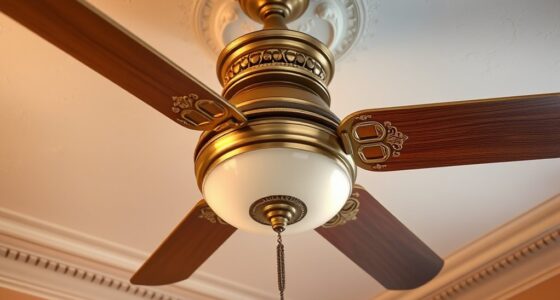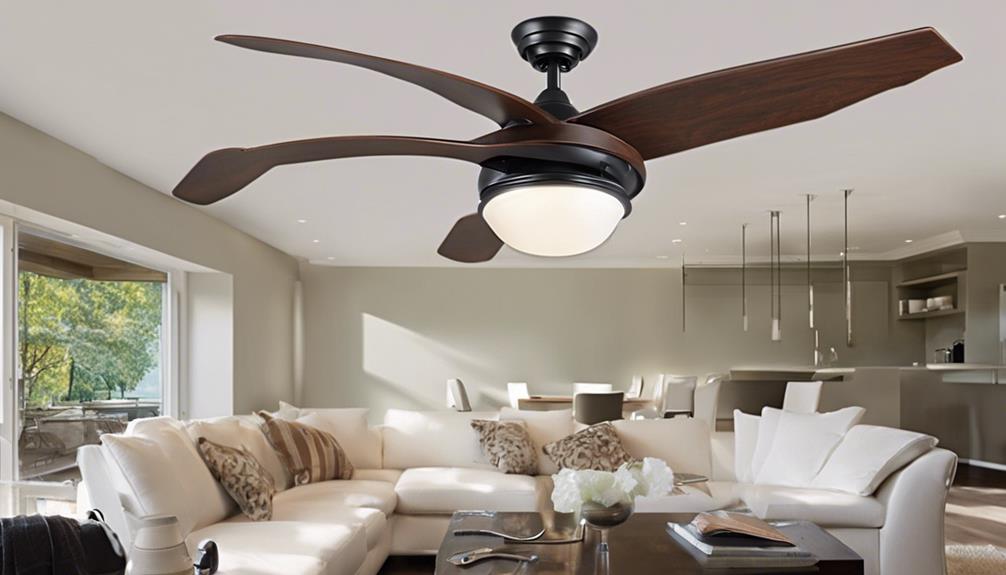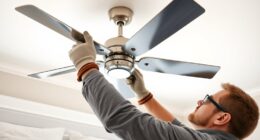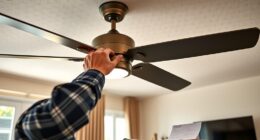A ceiling fan's an electric appliance that circulates air, keeping your space comfortable without changing temperature or humidity. You can use it year-round, with most models featuring reversible motors for summer cooling or winter warmth. They're energy-efficient, consuming much less power than air conditioning, which helps save on utility bills. Available in various styles and sizes, ceiling fans can suit any room. Proper installation is key for safety and efficiency. If you're curious about choosing the right one for your home or how to maintain it, there's plenty more to explore on this topic.
Key Takeaways
- A ceiling fan is an electrically powered appliance designed to circulate air and enhance comfort without changing temperature or humidity.
- It often features integrated lighting, providing ambient illumination while saving space in a room.
- Ceiling fans come in various types, including standard, low-profile, chandelier, and outdoor models, with different blade sizes for room suitability.
- They are energy-efficient, consuming significantly less energy than air conditioning units and helping reduce utility bills.
- Proper installation and maintenance are essential for optimal performance, including appropriate mounting height and regular cleaning.
Definition and Functionality

A ceiling fan is a versatile home appliance designed to enhance your comfort by circulating air efficiently. This electrically powered device is mounted on the ceiling and uses hub-mounted rotating blades to create airflow within your room. By increasing air speed, it generates a cooling effect that helps evaporate moisture from your skin, improving your comfort without altering the air temperature or humidity levels.
Many ceiling fans come with integrated lighting, combining two essential functions into one unit. This not only saves space but also provides ambient light where you need it.
Most models feature reversible motors, allowing you to switch the direction of the rotating blades. In summer, you can set it to spin counterclockwise to cool the room, while in winter, you can reverse it to circulate warm air that may settle near the ceiling.
Effective airflow management is key to maximizing the benefits of your ceiling fan. Properly adjusting the air speed and ensuring the fan's design suits your space will greatly elevate comfort levels in occupied areas.
Historical Development

You might be surprised to learn that the earliest ceiling fan, called the punkah, dates back to around 500 BC in India and was manually operated.
Fast forward to the late 19th century, and electric ceiling fans began to revolutionize airflow in homes.
After World War I, these fans gained immense popularity, especially in warmer regions, shaping how we stay cool today.
Earliest Fan Innovations
The history of ceiling fans traces back to ancient innovations that laid the groundwork for modern designs. The earliest fan, known as a punkah, was invented in India around 500 BC. This manual device operated by pulling a cord to create airflow, showcasing humanity's desire for comfort.
Fast forward to the 1860s and 1870s in the United States, where rotary ceiling fans powered by water emerged, marking a significant advancement in fan technology.
Here are some key developments in fan history:
- Punkah: The earliest fan, used in ancient India for basic air circulation.
- Rotary Ceiling Fans: Introduced in the 1860s, these fans represented a technological leap.
- Philip Diehl: In 1882, he invented the first electrically powered ceiling fan using a sewing machine motor.
- Four Blades: By World War I, ceiling fans typically featured four blades for quieter operation and improved air circulation.
These innovations not only paved the way for modern ceiling fans but also established them as a cost-effective cooling solution, especially during hot climates.
Electrification Milestones
With the advent of electrification in the late 19th century, ceiling fans underwent a transformative evolution that greatly enhanced their functionality and appeal.
The first rotary ceiling fans, powered by water, emerged in the U.S. during the 1860s and 1870s, but it was Philip Diehl's invention of the electrically powered ceiling fan in 1882 that revolutionized mechanized air movement. By utilizing sewing machine motors, Diehl significantly improved air circulation in homes.
As we moved towards World War I, four-blade ceiling fans became the standard, offering quieter operation and greater efficiency in air circulation. This shift reflected a growing demand for comfort and convenience in indoor environments.
The popularity of ceiling fans surged in the 1920s, showcasing their role in enhancing living conditions. However, during the Great Depression, their usage declined, only to rebound in hotter regions where cooling was essential.
Post-War Popularity Surge
Following the advancements in ceiling fan technology during the late 19th and early 20th centuries, the post-World War II era marked a significant surge in their popularity.
As air conditioning became more common, ceiling fans remained a cost-effective cooling solution, especially in resource-limited areas.
Several factors contributed to this boom:
- Widespread Electric Infrastructure: Improved electric infrastructure allowed easy installation and use of ceiling fans in homes.
- High Household Adoption: By the late 20th century, about 75% of households in the U.S. had ceiling fans.
- Commercial Success: Companies like Hunter Fan Company and Emerson Electric played key roles in establishing and promoting ceiling fans during this period.
- Affordability in Developing Nations: The Usha Prima model in India during the late 1980s exemplified the increasing demand for affordable cooling solutions without the high energy costs of air conditioning.
This surge in popularity not only solidified ceiling fans as a staple in households but also showcased their versatility across various regions and economic conditions.
Energy Efficiency

Ceiling fans, in comparison to air conditioning units, offer a remarkable boost in energy efficiency. They consume considerably less power, using about 1/20th of the energy that an air conditioning system requires. This reduced energy consumption directly contributes to lower utility bills.
By enhancing sweat evaporation, ceiling fans create a cooling effect that allows you to set your thermostat higher, further minimizing your dependence on air conditioning.
When you use an Energy Star-rated ceiling fan, you can enjoy up to 20% more efficiency compared to standard models. For instance, a 70W ceiling fan can run for about 30 days at a cost of only $6, while an air conditioning unit could set you back around $64.52 for the same duration.
Moreover, the slight warmth from the fan's motor can improve comfort during colder months, making ceiling fans versatile year-round.
Types and Sizes

When selecting a ceiling fan, understanding the variety of types and sizes available is essential for achieving both ideal airflow and a harmonious aesthetic in your space. Here are some key points to reflect on:
- Types of Ceiling Fans: You can choose from standard, low-profile, chandelier, or outdoor fans, each tailored for specific uses and environments.
- Fan Size: Blade sizes typically range from 29 to 54 inches. For rooms up to 75 ft², opt for 29-36 inch blades; for spaces between 225-400 ft², go for 50-54 inch blades.
- Mounting Options: Low-profile fans work well for ceilings under 9 feet, while standard mounts use a downrod of 3-5 inches. For high ceiling heights, extended mounts can accommodate ceilings up to 120 inches.
- Decorative Styles: Contemplate fans with integrated lighting, bowl-shaped designs, and finishes like brushed nickel or oil-rubbed bronze to complement your decor. Additionally, selecting the right ceiling fan can significantly enhance air circulation and comfort levels in your home.
Installation and Mounting

When installing a ceiling fan, you need to take into account the mounting height requirements to guarantee safety and efficiency.
You'll want to measure your ceiling height accurately to choose the right installation method and downrod length. This way, your fan will operate effectively while keeping its lowest point at least 7 feet off the floor.
Mounting Height Requirements
Proper mounting height is vital for both safety and airflow efficiency with ceiling fans. To guarantee you achieve the ideal airflow and maintain safety, consider these guidelines:
- Minimum Height: Mount your ceiling fan at least 7 feet (2.13 m) above the floor to promote safety and allow for adequate airflow.
- Ceiling Height: For ceilings under 9 feet (2.74 m), opt for low-profile fans to guarantee proper clearance and performance.
- Downrod Length: Standard installations typically use a downrod of 3-5 inches, while higher ceilings may require downrods ranging from 6 to 120 inches.
- Sloped Ceilings: If your ceiling is sloped, use angled mounts to keep the fan blades level, guaranteeing efficient operation.
Accurate measurement of your ceiling height is vital for selecting the right downrod length, assuring that the fan's lowest point remains at least 7 feet from the floor.
Installation Methods Explained
After ensuring your ceiling fan is mounted at the right height, it's time to explore the various installation methods available.
First, consider the ceiling height. For ceilings under 9 feet, low-profile fans are ideal, as they don't require a downrod. For standard installations, a downrod length of 3-5 inches is typically used. If you have high ceilings, you'll need extended mounts with downrods ranging from 6 to 120 inches to maintain optimal air circulation.
For sloped ceilings, angled mounts are vital to keep the fan blades horizontal, ensuring proper airflow.
Accurate measurement of your ceiling height is essential; the fan's lowest point must remain at least 7 feet from the floor for safety and efficiency during operation. Additionally, ensure the fan operates within a safe distance from the electrical box to prevent any electrical hazards.
As you proceed, make sure to secure the electrical box firmly and check all proper wiring connections. This will guarantee safe and effective fan operation.
Popular Brands and Models

Ceiling fans have become essential in many homes, blending functionality with style. When it comes to choosing the right ceiling fan, several popular brands and models stand out for their quality and design. Here are four top choices you might consider:
- Hunter Fan Company: Known for its quiet operation and energy-efficient fans, the Hunter Conversion 52-Inch Ceiling Fan is highly rated for its performance.
- Minka-Aire: This brand is celebrated for its stylish designs, especially the Light Wave LED 52-inch Ceiling Fan, featuring contemporary Koa wood finishes that enhance any decor.
- Honeywell: The Carnegie Industrial Farmhouse LED Ceiling Fan combines energy efficiency with attractive lighting options, making it a favorite among homeowners looking for both function and style.
- Emerson Electric: With a long history in the industry, Emerson offers several models that prioritize durable performance, ensuring your fan lasts for years.
Additionally, Usha Prima has made a mark in India since the late 1980s, showcasing the global appeal and commercialization of ceiling fans.
No matter your choice, these brands provide a range of options to suit different tastes and needs.
Global Trends and Usage

Across various regions, ceiling fans are becoming increasingly popular due to their ability to provide comfort while remaining cost-effective. Particularly in hot climates like India and the Middle East, these fans serve as an affordable alternative to air conditioning. Their energy-efficient operation is appealing, especially in resource-limited areas, where affordability is a significant factor driving adoption. Additionally, similar to heat pumps(Coefficient of Performance), ceiling fans can enhance thermal comfort while consuming less energy compared to traditional cooling systems. *Moreover, the principles of vibrational energy suggest that a comfortable environment can significantly influence overall well-being.*
The global market for ceiling fans has experienced a resurgence, propelled by innovations in design and technology that cater to modern consumer needs. Today's ceiling fans aren't just functional; smart ceiling fans have emerged, allowing you to integrate them with home automation systems for enhanced convenience and functionality. This trend reflects a shift towards more technologically advanced home appliances, including energy-efficient heat pumps, which support sustainability goals.
Moreover, there's a growing demand for environmentally friendly and energy-efficient ceiling fan models, underscoring a broader commitment to sustainability. As consumers become more conscious of their environmental footprint, selecting ceiling fans that align with these values becomes essential. Overall, the evolution of ceiling fans demonstrates their adaptability to changing lifestyles and preferences, making them a staple in contemporary homes worldwide.
Buying Considerations

When you're in the market for a ceiling fan, several key factors can make a significant difference in your overall satisfaction. To guarantee you choose the right fan, consider the following aspects:
- Room Size: Select a fan based on the room size. For small rooms (50-75 sq ft), look for blade sizes between 29-36 inches. Larger rooms (225-400 sq ft) require 50-54 inch blades.
- Ceiling Height: Determine the appropriate mounting option. If your ceiling is under 9 feet, go for flush mounts. For higher ceilings, downrod mounts work best to guarantee ideal airflow.
- Energy Efficiency: Look for fans with Energy Star certification, as they use up to 20% less energy than standard models, which can lead to savings on your energy bill. Additionally, using modern Energy Star certified fans can raise the thermostat temperature by 4°F, further enhancing energy savings.
- Smart Ceiling Fans: Consider modern designs that integrate with WiFi and smart home systems. These fans allow you to control lighting and airflow through apps or voice commands, adding convenience to your lifestyle.
Maintenance and Care

Maintaining your ceiling fan is just as important as choosing the right one, as regular care helps guarantee peak performance and longevity.
Start by cleaning your fan every week or two. Use a dusting spray and cloth to wipe away dust and debris from the blades and housing. Don't forget to wash the lighting globes in soapy water every few months to keep them bright and clear.
Annual lubrication of the moving components is essential for smooth operation. This prevents dust accumulation that can damage parts over time.
Additionally, check and tighten screws periodically. This simple step can prevent wobbling, enhancing both the stability and performance of your fan.
If you notice any wobbling during operation, consider using a balancing kit to address the issue. This can optimize airflow and reduce noise, ensuring your fan runs quietly and efficiently.
By following these maintenance tips, you'll not only prolong the life of your ceiling fan but also improve its overall effectiveness in cooling your space.
Regular care is key to enjoying the full benefits of your ceiling fan for years to come.
Frequently Asked Questions
What Is the Purpose of a Ceiling Fan?
The purpose of a ceiling fan is to enhance your comfort by creating airflow in your space.
It helps you feel cooler during warmer months through evaporative cooling and a wind chill effect.
In winter, you can reverse the fan to circulate warm air, making your room feel cozier.
Plus, it uses much less energy than air conditioning, saving you money while also often providing lighting, making it a versatile addition to any room.
What Is the Definition of a Ceiling Fan?
You might define it as an electrically powered device mounted on your ceiling, designed to circulate air in your space.
It's got rotating blades that increase air speed, creating a cooling effect without actually lowering the room's temperature.
Many ceiling fans also double as light fixtures, adding illumination while enhancing comfort.
Whether you need a stylish addition or just practical airflow, it serves both purposes effectively in your home.
What Is the Difference Between a Ceiling Fan and a Fan?
Imagine a gentle breeze dancing through a grand hall, lifting your spirits as it swirls overhead.
That's the essence of a ceiling fan, which spreads cool air across a larger space.
In contrast, a standard fan is like a loyal companion, delivering a focused gust where you need it most.
While ceiling fans can light up a room, portable fans simply offer relief, each serving its own purpose in your comfort quest.
Do Ceiling Fans Cool the Air?
No, ceiling fans don't actually cool the air. Instead, they create airflow that helps sweat evaporate from your skin, making you feel cooler.
If you want maximum comfort, remember to adjust the fan speed and direction based on the season. In summer, set it to spin counterclockwise for a revitalizing breeze, while in winter, use clockwise to circulate warm air.
Just don't forget to turn it off in unoccupied rooms to save energy!
Conclusion
To summarize, a ceiling fan isn't just a stylish addition to your space; it's a smart investment. Did you know that using a ceiling fan can save you up to 30% on cooling costs in the summer? By circulating air effectively, these fans keep your home comfortable without relying solely on air conditioning. So, whether you're choosing a sleek design or a powerful model, remember that your ceiling fan can make a real difference in energy efficiency and comfort.









